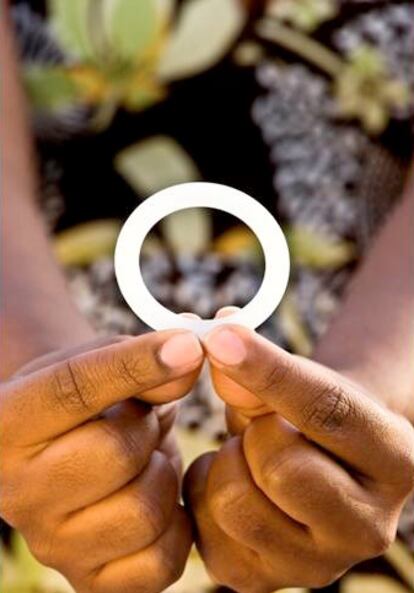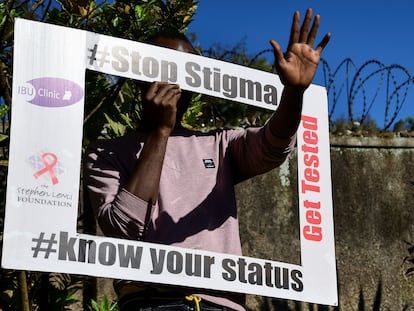How to protect women in the country most affected by AIDS: ‘I’m sick of begging my boyfriend to use condoms’
South Africa — HIV’s Ground Zero — pilots the ring method, which can reduce the risk of infection by up to 50%

Ntokozo Dlamini, 29, sits in the sun, stirring a steaming pot of porridge outside her mud hut. She looks up at the blue sky. “Soon I will have to go to the clinic again,” she says. “It’s far away, but I have to get my pills.” She sighs and wipes her forehead, which is shiny with sweat. She is referring to the preventative medication against human immunodeficiency virus (HIV), which consists of two drugs, emtricitabine and tenofovir, which can reduce the chances of contracting HIV sexually to almost zero.
Dlamini lives in the Valley of a Thousand Hills in South Africa’s lush KwaZulu-Natal. The province is one of the country’s most picturesque regions, with green mountains giving way to golden fields of sugarcane. It is also home to millions of people testing HIV-positive. The new global HIV report, released November 28, estimates there were 1.3 million new cases in 2022, with South Africa still leading the list.
Drugs such as those taken by Dlamini are called PrEP, short for pre-exposure prophylaxis. The tablets must be taken daily and at the same time every day. According to Ntombenhle Mkhize, CEO of the country’s AIDS Foundation, for many women, especially those living in poverty, this is not as simple as it sounds. “First of all, it’s easy to forget to take medication,” he says. “There is also still a lot of stigma around HIV in South Africa, so women, especially, are afraid to take pills associated with prevention. They dread people finding them out.”
In the face of this stigma, those in charge of prevention like Mkhize are “excited” about a pilot program for the use of the dapivirine vaginal ring (DVR), the world’s first topical HIV prevention method, recommended in January 2021 by the World Health Organization (WHO) as an additional preventative option for women at substantial risk of infection. South Africa has just received 16,000 vaginal rings, with support from The Global Fund. The reach of this prevention method may be made to extend further: on November 30, the nonprofit Population Council announced that a factory in South Africa will start producing rings that are cheaper and thereby accessible to a greater number of people.
Additional prevention choice
The PrEPWatch platform estimates that the ring reduces the risk of contracting HIV by 35%, while more recent data indicates even greater protection: a risk reduction of about 50%. Twenty-year-old Dlamini is “impatient” to try the ring. “I’m sick of begging my boyfriend to use condoms,” she says.
“The ring is a very important addition to our prevention tools,” says Professor Linda-Gail Bekker, director of the Desmond Tutu HIV Center at Cape Town University and one of Africa’s leading HIV scientists, who has conducted DVR trials throughout South Africa. “It consists of a fairly flexible silicone ring; it fits in the palm of the hand very easily, and contains an antiretroviral agent called dapivirine. Once inserted into the vagina, the ring sits comfortably over the cervix and the woman is unaware of its presence. Then, slowly, over the course of a month, it releases dapivirine. If the user comes into contact with the virus via the vagina, the dapivirine is there to prevent the virus from entering her body and infecting her,” she tells EL PAÍS.
Sibo Shange, 22, born in Khayelitsha, Cape Town, is one of the few South Africans to have used the ring to date. “I put it in myself and I am already [partly] protected against HIV,” she says. “I have control over my own body. I know I’m not protected against other [sexually transmitted] diseases, but even so. Also, using the ring means I don’t have to carry pills on me and take them every day. I put in a new ring once a month and that’s it. It’s great,” adds Shange, who has also used a bimonthly PrEP injection for protection in the past, but explained that, “because of work, it’s often very inconvenient for me to go to the clinic to get a shot. But I hope to be able to go soon and get the rings supplied so I can put them in at home.”
Largest antiretroviral therapy program
The Joint United Nations Program on HIV (UNAIDS) estimates that, worldwide, more than nine million of the 39 million people living with HIV still do not have access to antiretroviral drugs and that 630,000 people have died of AIDS-related illnesses, more than one per minute, in the past year. The figures, it says, are better than those of previous years, but progress is not fast enough to meet the global objectives — that 95% of the population with HIV know they are positive, that 95% receive therapy and that 95% have a viral load so low that it can neither be detected nor transmitted. According to the latest figures from UNAIDS, of the 39 million HIV-positive people worldwide last year, 20.8 million lived in eastern and southern Africa, with 8.45 million in South Africa alone, accounting for almost 14% of victims.
Moreover, of the 630,000 AIDS-related deaths in 2022, 260,000 lived in eastern and southern Africa, according to UNAIDS. But in South Africa, most HIV-infected people no longer end up in a grave. The government runs the world’s largest antiretroviral therapy program, providing the cocktail of drugs known as antiretroviral therapy (ART) that prevents replication of the virus to the point of making the viral load impossible to detect and therefore to transmit. In total, some 5.5 million South Africans take these life-prolonging antiretroviral drugs every month.
“We provide the HIV prevention pill every month to more than one million public health users, mostly young women,” says Thato Chidarikire, acting chief director of South Africa’s National Department of Health for HIV/AIDS. Women aged 15 to 24 are the largest demographic in the country to have started using the preventive pill. “This is also the group that has the fastest growing rate of HIV infections in South Africa, so we really need to reach them with PrEP,” Chidarikire tells EL PAÍS.
Mitchell Warren of the New York-based AVAC group, which manages PrEPWatch, acknowledges that the protection offered by the ring is far inferior to that offered by the preventive pill. “But models have shown that even a partially effective prevention option can offer women significant protection if it is part of a comprehensive HIV prevention strategy,” he explains. “That’s why we are very pleased that the ring is going to be available in South Africa.”
According to scientist Linda-Gail Bekker, the ring doesn’t appeal to everyone. But, she adds, “I think, just like with contraceptives, the more choices we give women and the easier we make it for them to access those choices, the more likely they are to find something that really fits in with their lifestyle and that they want to use.” Bekker says that if there are “good, clear, unambiguous messages” around the ring, it will soon be widely accepted among South African women. “It’s a very important development in a country where HIV already plays such a horrific role in everyone’s life,” she says.
Sign up for our weekly newsletter to get more English-language news coverage from EL PAÍS USA Edition
Tu suscripción se está usando en otro dispositivo
¿Quieres añadir otro usuario a tu suscripción?
Si continúas leyendo en este dispositivo, no se podrá leer en el otro.
FlechaTu suscripción se está usando en otro dispositivo y solo puedes acceder a EL PAÍS desde un dispositivo a la vez.
Si quieres compartir tu cuenta, cambia tu suscripción a la modalidad Premium, así podrás añadir otro usuario. Cada uno accederá con su propia cuenta de email, lo que os permitirá personalizar vuestra experiencia en EL PAÍS.
¿Tienes una suscripción de empresa? Accede aquí para contratar más cuentas.
En el caso de no saber quién está usando tu cuenta, te recomendamos cambiar tu contraseña aquí.
Si decides continuar compartiendo tu cuenta, este mensaje se mostrará en tu dispositivo y en el de la otra persona que está usando tu cuenta de forma indefinida, afectando a tu experiencia de lectura. Puedes consultar aquí los términos y condiciones de la suscripción digital.
More information
Últimas noticias
Iranian women are also defying the taboo of riding motorcycles (and without a license)
David Bowie, the galactic thinker who encouraged us to break new ground
John Berger and the loss of rural culture
From police officer to bloodthirsty kidnapper: Terror in Mexico during the years of ‘The Ear Chopper’
Most viewed
- David King, chemist: ‘There are scientists studying how to cool the planet; nobody should stop these experiments from happening’
- Reinhard Genzel, Nobel laureate in physics: ‘One-minute videos will never give you the truth’
- Oona Chaplin: ‘I told James Cameron that I was living in a treehouse and starting a permaculture project with a friend’
- Mexico completes its trade shift with the entry into force of tariffs on China and countries without trade agreements
- Sinaloa Cartel war is taking its toll on Los Chapitos










































